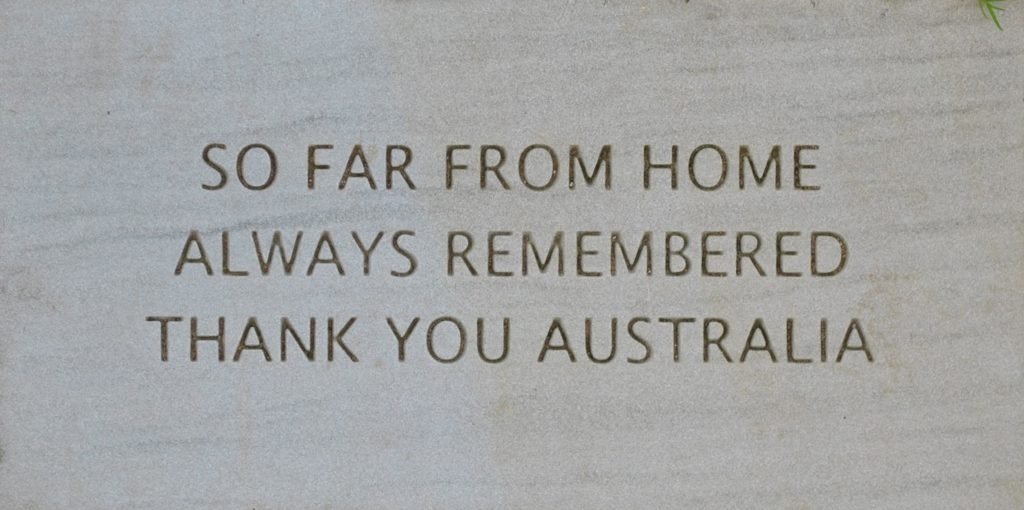
At the very end of the path that leads to the Memorial Walls, on the left hand side, there is a large Stone dedicated to all the Australian Air Force members who served in Bomber Command during WW2. Australian aircrew were trained in Australia, Canada and Rhodesia under the Empire Air Training Scheme (EATS), before they arrived in the UK to serve in Bomber Command. The first ground instruction and flying schools opened in Australia in 1940 and by March 1941 the graduates were joining the UK based Squadrons.
Approximately 10,000 Royal Australian Air Force personnel served with Bomber Command and 3,486 were killed, 650 died in training accidents and 1500 became Prisoners of War. Many served on the eight RAAF Bomber Command Squadrons, namely 455, 458, 460, 462, 463, 464, 466 and 467 Squadron.
The first two Australian Squadrons formed were No 455 Sqn in June and No 458 Sqn in September 1941. By the end of 1941 both were flying regular missions against Germany. Although the Australian Government wanted to consolidate their airmen into RAAF units, there was never an Australian Bomber Command Group, compared to the likes of No 6 (Canadian) Group. Even the Australian Squadrons often had a small number of Australians on them, as the men tended to form into crews at the Operational Training Units, without regard for nationality, and didn’t wish to be broken up when they eventually arrived on the Squadrons. Some Commanders favored mixed nationality crews, so we find many Australians serving in various Squadrons throughout Bomber Command.
The arrival of No 460 Sqn RAAF to RAF Binbrook in spring 1943, caused quite a stir. The Squadron was transferring from RAF Breighton and the groundcrew were given the options of traveling by train or being transported in Horsa gilders, over 800 of them chose to travel by Horsa. Their different uniforms and accents also caused problems, with one local schoolboy running home to his parents and declaring the Germans had arrived! During the next two years of the war, 460 Sqn suffered some of the highest casualty rates in Bomber Command.
Depicted on the Stone is the badge of the Royal Australian Air Force and the Australian War Memorial which is in Campbell, a suburb in the capital Canberra. This Memorial was unveiled on the 11th November 1941 and holds the Rolls of Honour which commemorates over 102,000 members of the Australian Armed Forces who have died during War Service, and since 1945, those killed in Wars and certain Peacetime Operations. The Tomb of the Australian Unknown Soldier is located here, along with an extensive National Military Museum.
Towards the bottom of the Stone, we have an inscription from a letter written by Fg Off Colin Kelvin Flockhart who served on No 619 Sqn. Colin was born on the 1st February 1924 in Ashfield NSW. He attended school in Sydney, completed his accountancy studies before gaining employment with the Commonwealth Bank. When old enough he joined the RAAF and qualified as a pilot in 1942. After completing his flying course, he was sent to Canada for further training before arriving in England. He converted onto the Lancaster and was posted to No 619 Sqn based at RAF Strubby here in Lincolnshire. On the 1st December 1944 Colin wrote a three page letter to his parents to be delivered in the event of his death. He described how he was happy in the RAAF, his belief in what he was doing, his faith in God and his appreciation of his family.
I have been very proud to wear my uniform, keep smiling although your hearts are breaking.
These words were extracts from his letter home, a letter that would soon be delivered to his parents in Earlwood NSW. On the 7th January 1945 Flockhart and his crew were detailed to take part on a raid on München. Flying in Lancaster ND957 PG-M, they were returning from the target in bad weather and reduced visibility, when their aircraft disintegrated over St Pierre in France. It is thought a possibly collision occurred with a 49 Sqn Lancaster PB586, also returning from München. That accident caused the death of three Australians, FS Eric Smith from Sydney was Colin’s Wireless Op on ND957, and WO Frederick Miller from Canberra was the Wireless Op on the 49 Sqn aircraft. Those on board both aircraft were laid to rest in Villeneuve St Georges Old Communal Cemetery 18 Km South East of Paris. Fg Off Colin Flockhart was just 20 years old at the time of his death.
It wasn’t just the aircrew who made the ultimate sacrifice, Sgt Laurence Parker was born in Bundaberg, Queensland. He served as groundcrew on No 467 Sqn based at RAF Waddington. Most aircraft had nose art which depicted how many raids an aircraft and crew had completed. The nose art was normally a bomb, but Sgt Parker suggested using beer mugs to record the event, and painted these onto the aircraft he serviced. On the 4th December 1943 Laurence was killed when a Lancaster JB140 crashed on takeoff after two engines failed. The aircraft swung violently, leaving the runway before the pilot managed to get it under semi control. Unfortunately, it hit a parked No 61 Sqn Lancaster before crashing into Sgt Parker and a Sgt Hobba. Ironically Laurence was killed by an aircraft he serviced himself, whilst Sgt Hobba survived with slight injuries. The following day FS Cecil Frizzell the Air Gunner on JB140, who hailed from Queensland, succumbed to his injuries.
The bravery, gallantry and sacrifices of all those who served in the RAAF in Bomber Command during the war is reflected in the medals awarded to Australian personnel. 2 Victoria Crosses, 62 Distinguished Service Orders, 1 Military Cross, 1609 Distinguished Flying Crosses, 3 Air Force Crosses, 1 Distinguished Conduct Medal, 6 Conspicuous Gallantry Medals, 1 Military Medal, 297 Distinguished Flying Medals and 3 Air Forces Medals.
